Startups
Auto Added by WPeMatico
Auto Added by WPeMatico
A malfunction in Facebook’s Software Development Kit that lets apps add Login With Facebook, sharing, and other features caused apps that integrate it like Timehop to repeatedly crash for about three hours. TechCrunch received a tip that developers were getting tons of user complaints and crash reports starting around noon pacific today due to a problem with the Facebook for iOS SDK. TechCrunch’s testing verified that products like Timehop, Joytunes’ Simply Piano, Momento GIFs, and more kept breaking when users access Facebook features or in some cases just opened the app.
This is a big issue for Facebook because it relies on these apps to drive user lock-in. If people use Facebook to log into or share from other apps, they’re less likely to delete their account. But if the Facebook developer platform screws up like this morning, developers could instead highlight sharing via Twitter or SMS, and divert ad buys to other platforms. Most problematically, the bug could push developers to other login platforms like Google’s or Apple’s new Sign In With Apple.
[Update: 3:45pm PT: Facebook has fixed the bug and apps integrated with the SDK are starting to work normally again. A Facebook spokesperson tells me “We started to work on the issue as soon as it was reported to us, and it has been resolved.” Facebook engineer Ram Sharma posted that “Our engineering team worked to resolve this issue as soon as it was discovered. It is now mitigated and app function should be restored.” Developers confirm the bug has been fixed. The rest of this article remains as originally published.]

The bug was initially submitted to Facebook’s developer forums by Ryan Layne. These crashes thwart normal usage of other apps, costing their developers ad views and in-app purchases, or leading their users to uninstall or abandon them.
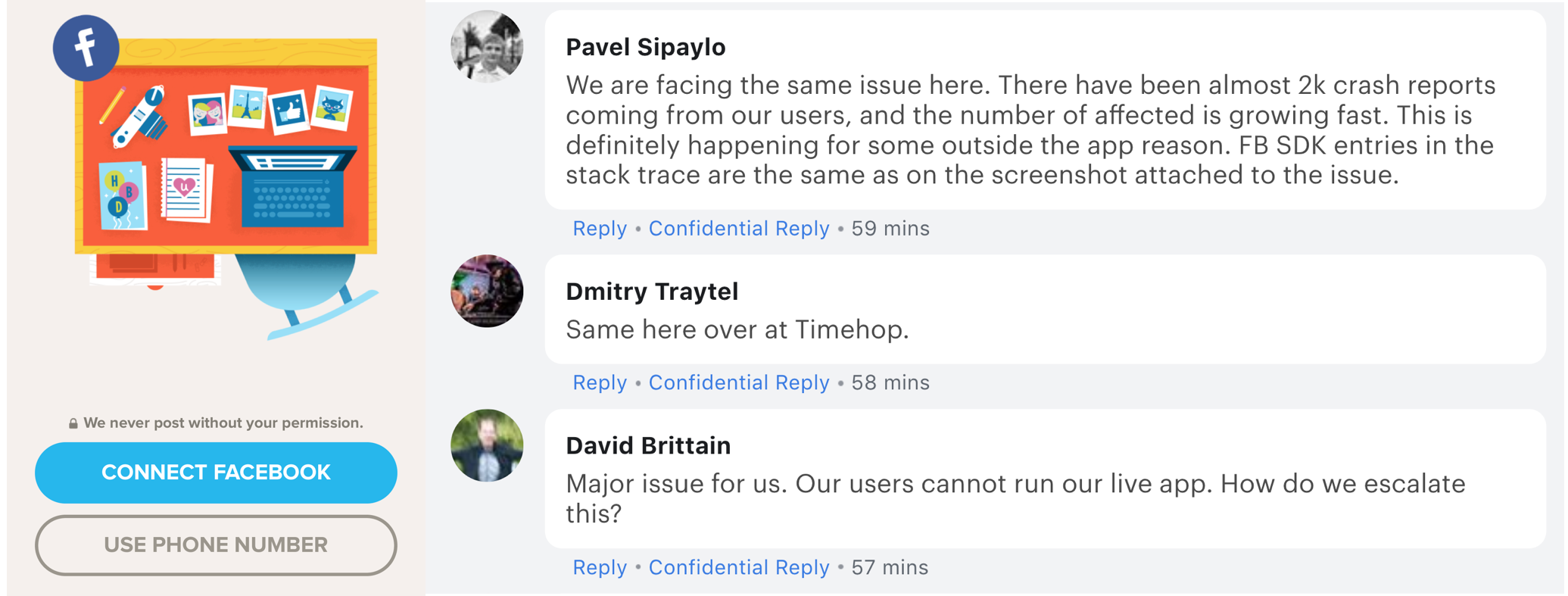
Hitting the Connect Facebook button on Timehop causes the app to crash. Developers in Facebook’s bug reporting forum pile on saying their apps are breaking
The situation highlights the increasing centralization of the web as more and more companies depend on a small number of mobile, hosting, and social platforms. Earlier this month, a Google Cloud outage knocked down Snapchat and Discord. While these tools make it simpler to start a company or launch an app without having to build everything in-house, they introduce platform risk. Beyond technical outages, there’s also the concern that a platform could use its insights to copy its clients, or block them if they compete with the gatekeeper too vigorously as Facebook has done to chat and social media apps in the past.
Powered by WPeMatico
There’s seemingly no end in sight for DoorDash’s compensation model where it subsidizes driver wages with customer tips. The mildly bright side, however, is that DoorDash is now providing more transparency after each completed delivery, DoorDash CEO Tony Xu wrote in a blog post today.
“With our current pay model, Dashers see a guaranteed minimum — including tips — prior to accepting a delivery,” Xu wrote. “The guaranteed minimum is based on the estimated time and effort required to complete the delivery. Providing this guarantee upfront means that Dashers are more likely to accept all kinds of deliveries because they know what their earnings will be even if the customer provides little or no tip.”
That means DoorDash’s base pay is sometimes just $1.
“Talking about transparency is good,” labor rights group Working Washington said in a statement to TechCrunch. “And admitting you pay $1/job is better than denying it. But $1 is still $1.”
In light of pay controversies at Instacart, DoorDash and Postmates, Working Washington formed the Pay Up Campaign, which unites thousands of workers across all those gig economy platforms.
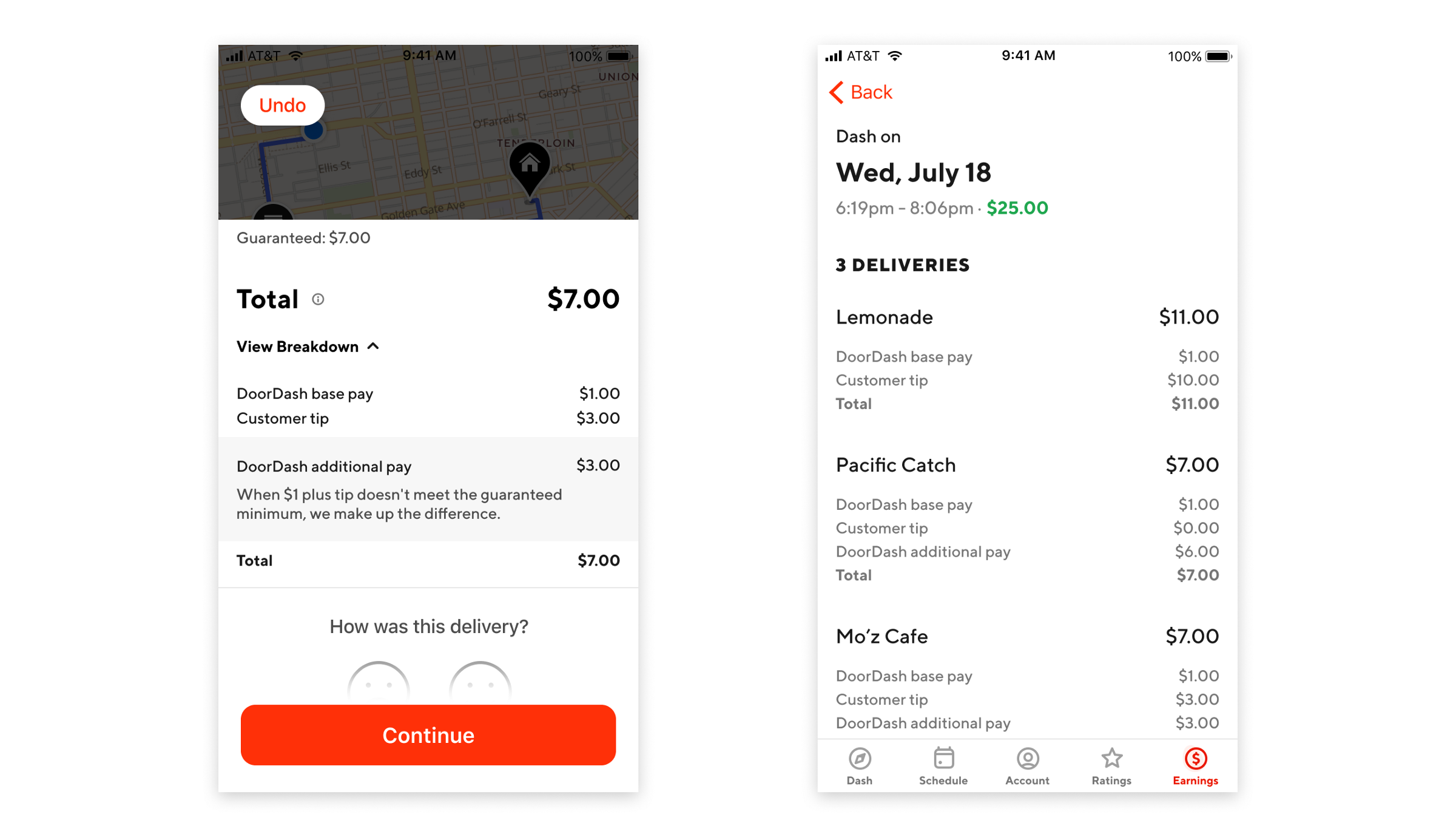
“They continue to subtract tips from worker pay,” the organization said in its statement. “And they continue to mislead customers about where their tips are going. When a customer tips more, DoorDash pays less — in other words, the customer is tipping the company.”
Despite what DoorDash said in its blog post about what workers want, the Pay Up campaign says it wants a minimum pay floor of $15 per hour plus expenses for time with an active job, tips, and a detailed breakdown of pay.
Powered by WPeMatico
In the early 2000s, journalists popularized the term “PayPal mafia” to describe the PayPal founders and employees who left to start their own wildly successful tech companies, including Peter Thiel, Reid Hoffman, and Elon Musk. Drawing from that idea, this article seeks to cover the formation and flow of talent within the crypto landscape today.
I’m fascinated by the concept of tech mafias, popularized by Paypal in the early 00s.
Early signs of crypto mafias:
Coinbase
@0xProject @dydxprotocol
Ethereum/ConsenSys@Cardano @polkadotnetwork @metamask_io
MIT@EnigmaMPC @Algorand Unit-e
IC3Avalanche
Others?
— Ash Egan (@AshAEgan) April 3, 2019
The crypto world is in a constant state of flux, with new startups entrants joining the industry every single day. These new startups have the potential either to be superstars within a portfolio company or to start the next Coinbase. Additionally, there are already impressive spin-outs from some of the more established crypto companies.
For ease of framing, I’ve separated these early-forming mafias into four categories: Crypto, Tech, Wall Street, and Academia. Since 2009, there have been 186 spinout companies originating from those four categories (33% from Academia, 28% from Crypto, 24% from Tech, and 15% from Wall Street).
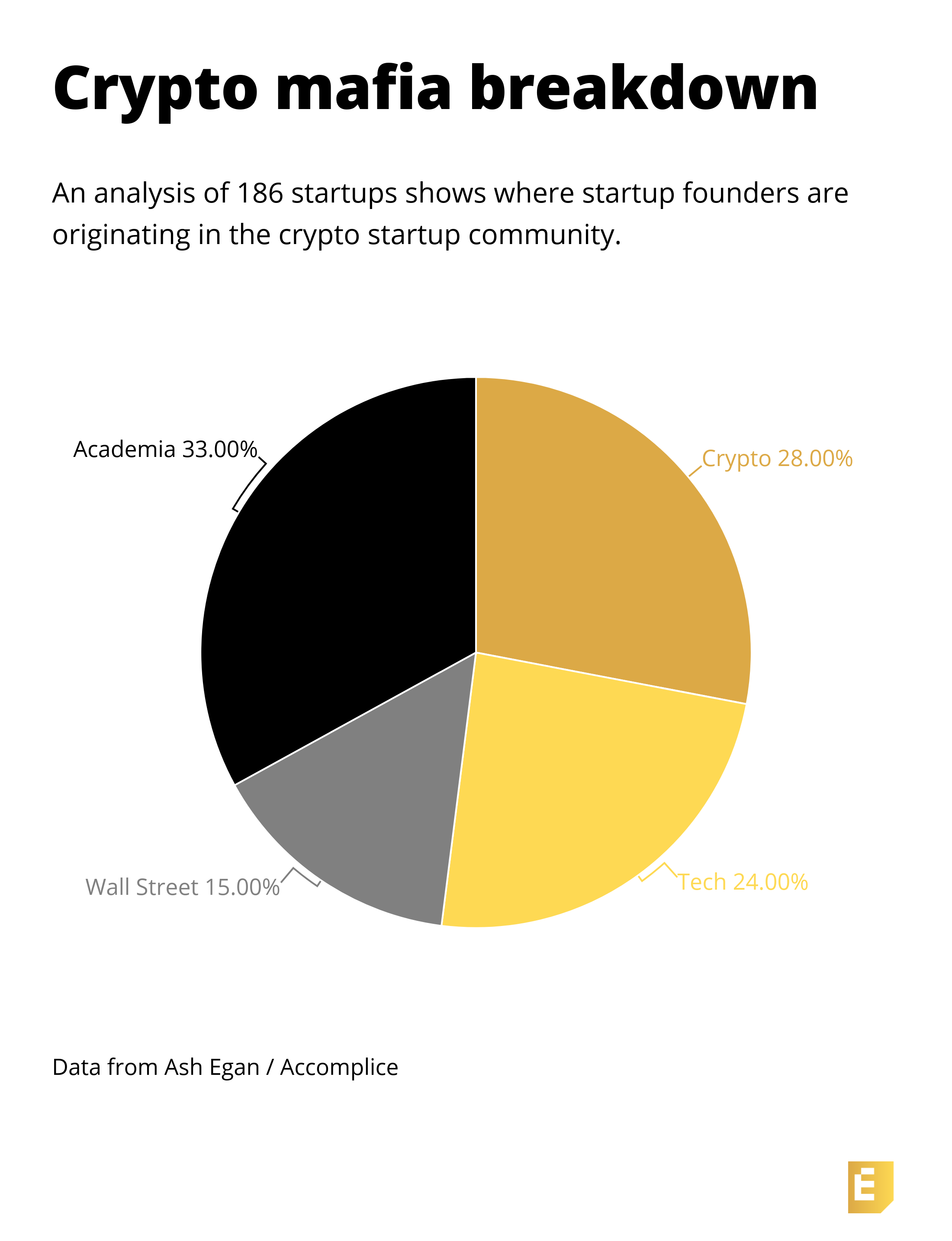
Obvious but important disclaimer: this article does not intend to promote organized crime within crypto.
Powered by WPeMatico
As brands pursue audiences online, they are producing more creative content than ever — particularly around Instagram.
In the past twelve months, Brandfolder‘s Brand Index (check out the full Brand Index Report at the end of this article) tracked an 80% increase in videos and other creative material targeted for the platform.
With the Instagram community being a highly engaged group, brands rely on rich, visual content to connect to them. With the proliferation of new Instagram features, like video, Stories, multi-photo carousels, and IGTV, each subset requires its own content, further inflating the need for more brand creative.
The growth in brand creative isn’t just due to audience demands, however. The shelf life of brand assets has fallen as more brands compete with other content (and each other) for user attention.
In 2016-2017, the average asset shelf life was 395 days. From 2017-2018, it was 280 days, with varying lifespans across file type and industry. That’s a 29% decrease in lifespan. Over the next few years, we predict this number will continue to decrease.
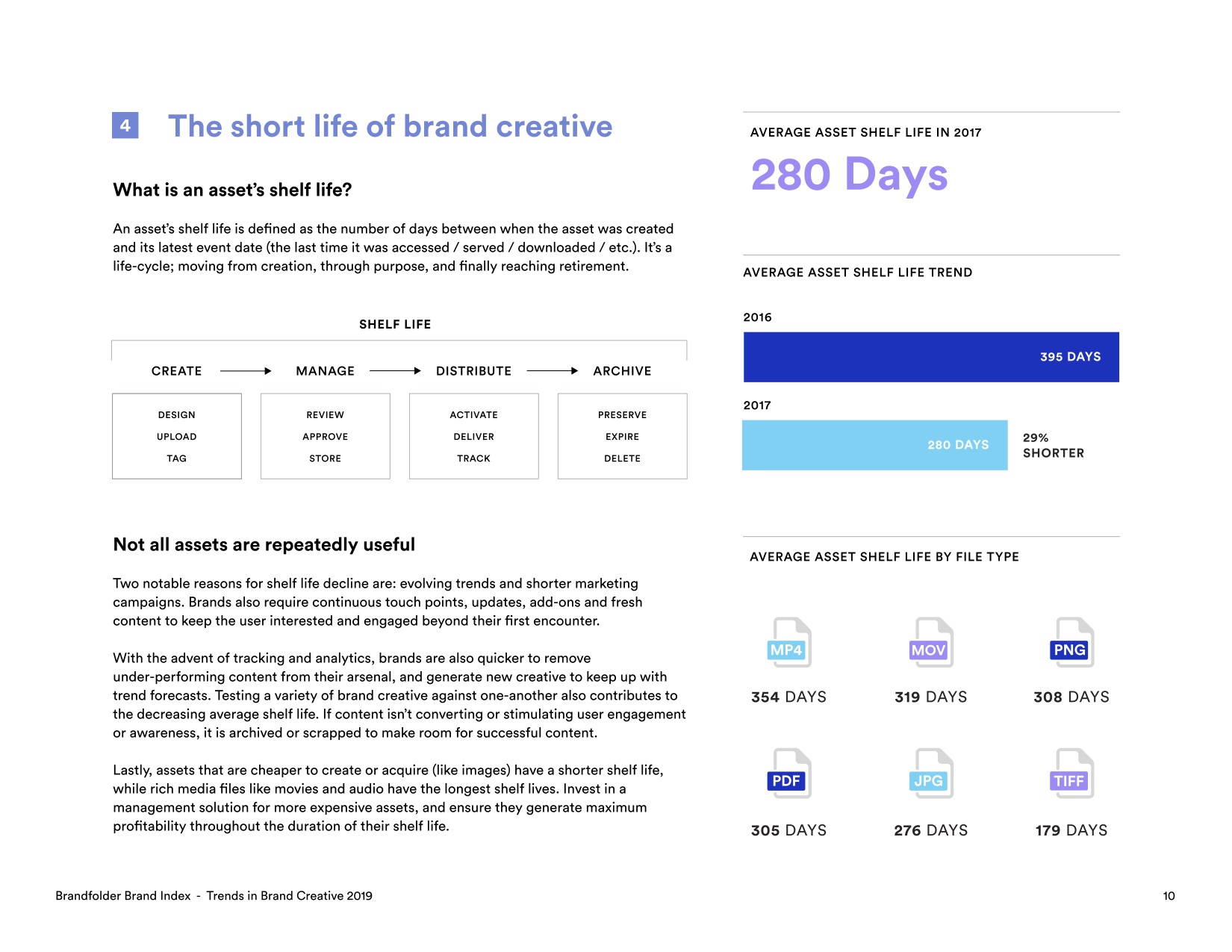
Check out the full Brandfolder Brand Index Report at the end of this article.
Which means, as brands are becoming increasingly dynamic and getting serious about personalization, the need for brand creative, more frequently, will continue to skyrocket in order to stay current and relevant.
To bring this to life, think about the last professional sports game you watched. You noticed one team on the field was wearing a throwback jersey with an old school logo. At a different game, they were back to wearing their normal jerseys with the most current logo.
Later in the season, however, the team is wearing pink jerseys for Breast Cancer awareness. This is a prime example of a dynamic brand expressing their creativity while adapting to varying circumstances, events, and audiences. All of this necessitates fluid brand creative.
But what exactly is brand creative? In the broadest sense, it refers to the all-encompassing collection of online and offline creative assets that a business uses to represent its brand. When we refer to brand creative, we refer to assets of all types–like videos, social media posts, product photography, lifestyle imagery, sales materials, logos, fonts, 3d renderings, and much more.
At Brandfolder, we are focused on delivering intelligence about our customer’s brand creative. We house and manage millions of creative assets from companies of all sizes–anyone from small-scale mom-and-pop shops to large-scale Fortune 10 companies.
And within this massive creative data set, our data science team extracts actionable insights through asset scoring algorithms, prediction formulas, collections, classification tools, and uniqueness analysis, to name a few.
Through these analyses mentioned above, our data science team created the Brand Index– a collection of high-level brand creative trends that CMOs, brand managers, agency professionals, and designers should use to guide their strategic campaigns and deliverables. It was built on discoveries from tens of thousands of creative assets stored in our digital asset management platform from more than 6,000 brands between 2016-2019.
Some brands house asset counts as low as 60, while others house as many as 38,000 assets or more. Specific information analyzed within the Brand Index includes amounts of assets, file formats, asset orientation, asset shelf life, event-based interactions with assets, and more. This information was then combined with the customer’s industry and anonymized to remove any identifying and brand-specific information.
In the Brand Index, companies can learn things like why and how brands’ digital footprints are growing exponentially. From 2017-2018, total asset count on a by-brand basis skyrocketed by 81%. And, it’s on track to continue climbing.
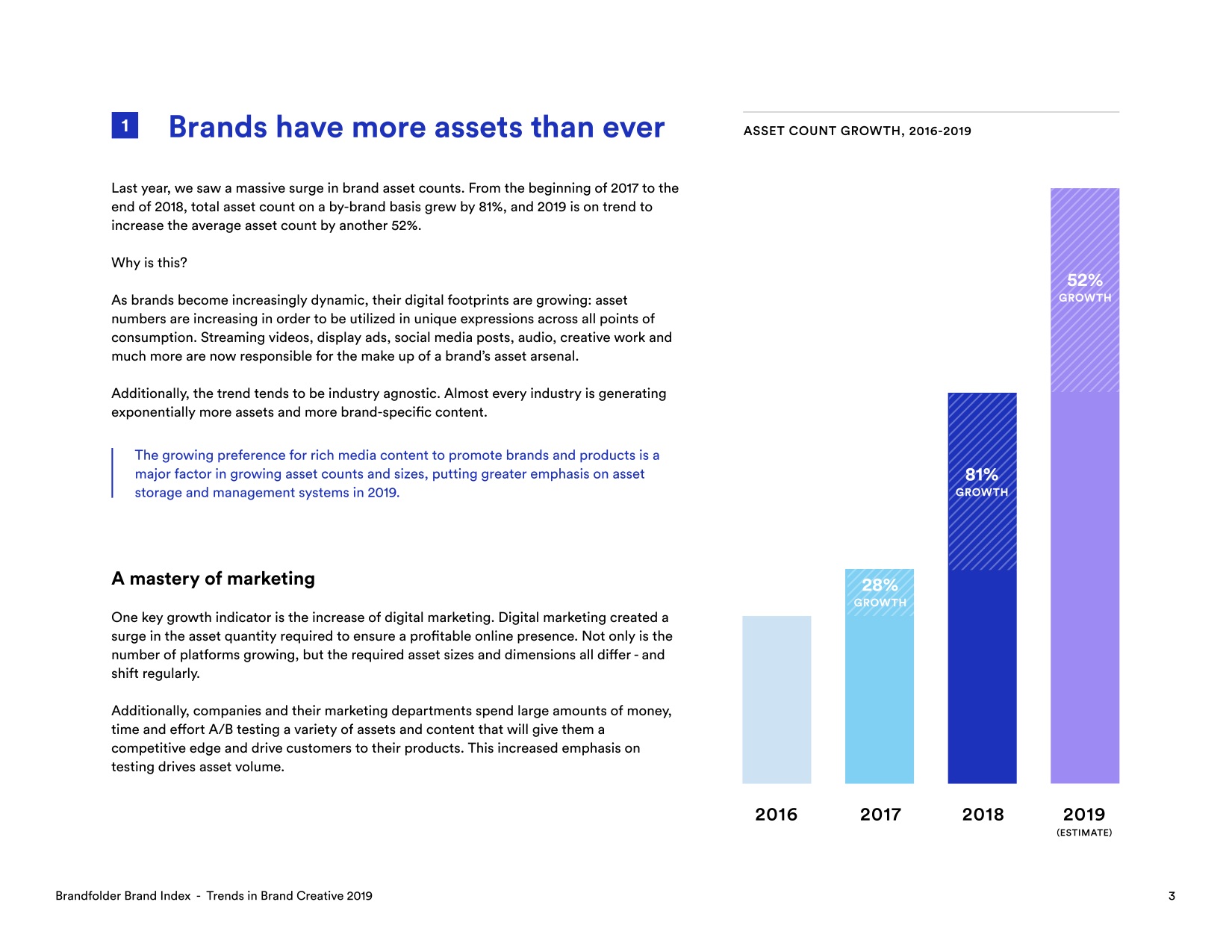
Check out the full Brandfolder Brand Index Report at the end of this article.
A major factor for this digital asset boom could be the increasing demand for rich and personalized media on multiple channels, putting an even greater emphasis on the need for a robust digital asset management platform.
Additionally, as CMOs and design directors are putting more time and effort into their brand creative, the need for understanding which assets perform better, when and where, will continue to rise. Brands are already taking advantage of optimizing their creative content based on rich insights.
Thus, by integrating testing data with a platform that provides asset-specific performance insights, brands will have the competitive edge they need to continue retaining and building equity in the minds of their consumers.
Our findings also show that companies should take note of the shift in file type and how brand creative needs to become increasingly dynamic in order to keep delighting their customers. Rich media files used for engaging and dynamic advertising are on the rise–with video being a key player.
Videos have become the go-to file format supporting a variety of marketing and business goals like sales, retention, upsell opportunities, customer experience, education, thought leadership, and more. JPGs still tend to be a brand favorite, however, gone are the days that these JPGs only live in one place. Asset versatility and responsiveness are critical for the increase of digital channels. Which leads me to my next point: brand identity.
Most brands now have at least four logo orientation and color variations that contribute to consistency and cohesion across their growing portfolio of channels. The brands that are succeeding in the marketplace have animated logos and other engaging asset types that they can switch out on any channel with the snap of a finger.
And as mentioned earlier, if the average shelf life of an asset differs by file type with a current average being 280 days or less, which file formats should brands continue to invest in order to maximize their ROI?
But, what does asset shelf life really mean? Asset shelf life is defined as the number of days between when an asset was created and its latest event date (the last time it was accessed, viewed, downloaded, distributed, etc.). An asset is just like a living, breathing creature. It moves from creation through purpose and finally reaches retirement or its, sometimes timely, archival.
Not all assets are created equal, however. With the creation of AI & ML technologies, brands are getting smarter about their content’s performance. High-performing brands are quicker to remove underperforming content from their arsenal and generate new brand creative to keep things fresh.
And with video on the rise, that also takes a big chunk of change out of marketing and creative budgets. Thankfully, but not ironically, we’re seeing that the asset types that take a larger investment also have longer shelf lives.
Companies should invest in a management solution for more expensive assets to ensure they are generating the maximum reach and profitability throughout their lives.
As brands look to scale their identities and creative asset production, as well as their distribution and delivery strategies, companies should take advantage of the Brandfolder Brand Index in order to ensure they aren’t left behind with the constantly evolving landscape.
Powered by WPeMatico
A $30-per-month email service capturing the adoration of investors and founders in Silicon Valley is perhaps an unsurprising story in a subscription-obsessed landscape, yet we’re only now hearing how stealth-y startup Superhuman has captured investor $$$.
The New York Times reports that the SF startup closed a $33 million Series B led by Andreessen Horowitz last month, raising at a $260 million valuation. The company has been oddly tight-lipped about its funding for a startup that people won’t stop talking about, though CEO Rahul Vohra has justified this as a desire to keep the story on the product not the money.
Superhuman has little need for a marketing budget when every VC’s twitter is spreading the gospel of luxury email.
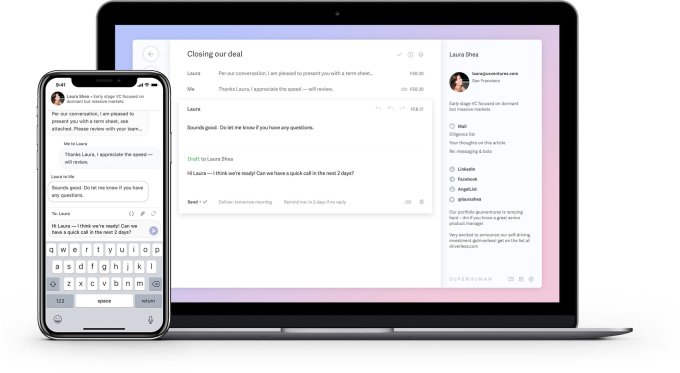
The startup has seemed to have grown at its own pace, the service’s members frequently reference the 100,000+ people on the waiting list to pay for the email app though the company seems most intent on growing by word of mouth referrals which allow you to hop the line. (Roose’s story details that list is actually 180k people long, and that the company has less than 15k on-boarded subscribers)
The service is designed around helping people that spend several hours in email every day to find areas to cut down on friction. What’s it like though?
I spent about 6 months paying for the service (thanks for the referral Niv) before eventually unsubscribing a couple months ago. There’s certainly plenty to love, though the price can be a bit to stomach when you realize how much you’re paying for email compared to other services.
Superhuman’s central strength is speed. Its other strength is that it feels like an exclusive club, though its members probably have nicer things to say about it than The Battery.
More on its functional differentiators in a bit, but the culture surrounding the app is a little fascinating. It’s a luxury app icon to have on your phone. You won’t find the Superhuman app in the App Store, you have to be approved for the service in iOS’s TestFlight where constant beta updates are delivered.
Other founders I’ve chatted with have been inspired by how Superhuman’s on-boarding process helps users feel like they’re getting a product custom-built for them. I met with Vohra during my 30-minute meeting where he walked me through the product and asked me about my own email habits as he helped me set up my account. The result is a bizarre connection with the product and team.
Example: for 30 days after you set up your account, you get an email from Vohra detailing some tips and tricks for using the service. Not only did I not immediately unsubscribe from these messages, I read almost all of them. When I filled out a survey at the end surrounding what I thought about the service, an employee at the startup shot me an email a few days later with a full response, I responded to that.
But honestly, how many paid services would expect its users to include a line in their signature plugging the service “Sent via Superhuman” and never disable it? And yet, the cult of Superhuman led me to keep it for awhile until my eyes were opened that flexing my $30/month email in my signature made me look like an asshole. Yes, it did.
What all of these interaction earn Superhuman is that when reality eventually beamed on me that I was not making VC money and I should probably end this little experiment, I almost felt like I had to apologize to the startup for cancelling my subscription. I felt so coddled as a member of the service with every new little update feeling like a new membership perk.
Okay, okay, yes, there are other ways to feel special that aren’t a $30/month electronic mail service. What is so nice about using it?
Speed is the top-line item. The desktop experience is the platform’s key differentiator, it’s structured entirely around keyboard shortcuts and the app is constantly training you to move through your email more quickly.
A couple of months in, I truly was spending far less time combing through pitches and tips, particularly thanks to the custom buckets that Superhuman sorts your mail into. The “Important” tab in your inbox differentiates newsletters and mailing list emails and only sucks in messages that were sent directly to you. It is miles better than the rudimentary sorting that Gmail pulls off.
If you aren’t used to the cult of “inbox-zero,” the service will drag you into it. The app prompts you to archive, snooze or delete every email in your inbox, transforming the utility of the service from a simple mailbox into a to-do list.
Other features like the souped up email tracking lets you know when your email was opened and does this much better than the free Gmail extensions I’ve tried. When a founder tried to claim he hadn’t seen my email asking him about some problems at his startup, I checked the app and saw he had opened it no less than 17 times on his phone and PC. Hmmm…
Before starting Superhuman, Vohra founded Rapportive which LinkedIn later bought. He kind of recreated that service for Superhuman which really allows you to get into people’s inboxes more easily. If you can guess someone’s email, a sidebar in the app will populate with a bio of the person if you’re correct. This is obviously pretty useful to a journalist, but if you’re trying to cold email your way into new opportunities it can be pretty great as well.
I’m perhaps not enough of a power user to get the most of snippets, which allow you to quickly inject canned responses that you can stylize, but they seem like they’d be amazing for intros though I rarely ended up using them.
When it comes to shortcomings, Superhuman is a desktop experience first-and-foremost. I’m a heavy mobile email user and the Superhuman app may have better than most other iOS email apps I had used, but it is still iterative on mobile and I think I was left thinking about the subscription costs most when I was swiping through emails there.
Even in the six months that I was a subscriber the mobile app made some hefty advances, though getting people to continually justify a subscription over what would otherwise be free is a challenge that won’t go away as long as it holds its price tag.
The issue for Superhuman is that in a lot of ways the app just trains you how to use email more effectively. Since cancelling my subscription, I’ve dialed in my Gmail keyboard shortcuts and shifted how I flag and archive messages and I’d say I’m operating fairly close to the efficiency I pulled off on the premium service.
The mental load of spending $30 month on email is admittedly heavy and is undoubtedly a barrier for Superhuman scaling to different echelons of users, but with $33 million from Andreessen Horowitz, the startup certainly has some options for how it grows from here. I do still dearly miss the “Important” tab, email tracking and sidebar profiles and perhaps I will eventually return though I imagine that will happen when the service costs less than what I put into Apple Music and Netflix combined.
Powered by WPeMatico
French startup Ornikar is raising a $40 million Series B round (€35 million) from Idinvest and Bpifrance. The company competes with traditional driving schools in Europe with an online marketplace of students and teachers.
And Ornikar has been a massive success in France. Overall, 35 percent of driving school registrations in 2019 are handled by Ornikar.
There are many advantages in choosing Ornikar. For driver students, Ornikar is much more flexible than a traditional driving school. Driving schools in France are usually pretty small with only a handful of employees. It’s sometimes hard to book lessons, especially if you have a full-time work.
When you sign up to Ornikar, you can connect to your Ornikar account and book an hour or two from there. Ornikar works with a pool of 650 instructors so that you get to study at your own pace.
Ornikar is also cheaper than a traditional driving school. By automating the administration work as much as possible, the startup says that it is 35 percent cheaper than a traditional driving school. It currently costs €750 for 20 hours of lessons.
“We’ve been profitable in 2018 and very profitable in 2019 for the French market,” Ornikar co-founder and CEO Benjamin Gaignault told me.
Here are some numbers. Every month, 30,000 people sign up to Ornikar in France. The startup manages 70,000 hours of lessons per month on its marketplace.
Ornikar works with qualified instructors who got a license to work in a driving school. They get paid €15 per hour, which is theoretically more than in a normal driving school.
With today’s funding round, the startup wants to expand to more countries. Ornikar is already live in Germany and Spain, but the company wants to grow the product there. Eventually, the company will also expand to Italy and the U.K.
In addition to new countries, Ornikar wants to sell other car-related products. The company is partnering with third-party companies for car insurance products, and there will be more products down the road.
Ornikar had previously raised an $11.3 million Series A (€10 million) and a $1.3 million seed round (€1 million). Existing investors include Brighteye, Partech, Elaia, Xavier Niel, Jacques-Antoine Granjon and Marc Simoncini.
Powered by WPeMatico
Did you miss the deadline to compete in the Startup Battlefield at Disrupt San Francisco 2019 on Oct. 2-4? Cheer up buckaroo. You may be down, but you’re not out. You have one last chance for Startup Battlefield glory.
“Tell me more,” we hear you cry. Buy a demo table and exhibit in Startup Alley at Disrupt SF for a chance to win a Wild Card entry to Startup Battlefield. Out of all the startups exhibiting in the Alley, our team of TechCrunch editors will select two standouts as Wild Card teams. Those teams will compete head-to-head in Startup Battlefield for $100,000 equity-free cash, the Disrupt Cup and plenty of investor and media attention.
Yes, it’s a longshot, but sometimes longshots pay off. Just ask the folks at RecordGram. Not only did the company reap the many benefits of exhibiting in Startup Alley, but it also earned a Wild Card slot and won the Startup Battlefield championship.
Whether or not you earn a Wild Card or compete in Startup Battlefield, exhibiting in Startup Alley offers almost infinite opportunity. More than 10,000 attendees will be on hand, and they’ll be hungry to explore everything Startup Alley has to offer. It’s a networking paradise where you just might connect with future customers, investors, partners, advisors, employees and marketers. Plus, with 400 media outlets attending, plenty of journalists will be trolling for great stories.
Caleb John, founder and CEO of Cedar Robotics, met hundreds of people demonstrating his company’s tech in Startup Alley. He calls the experience “one of the coolest things we’ve ever done.”
Of course, you get all the other benefits associated with your Startup Alley Exhibitor Package. Three full days of programming across all four Disrupt stages including the Main stage where you’ll hear a lineup of amazing speakers. You also receive access to interactive workshops, the complete attendee list via Disrupt Mobile App, CrunchMatch, our attendee-networking platform, networking parties, the TechCrunch After Party and exclusive video content access once the conference ends.
Disrupt San Francisco 2019 on Oct. 2-4. Come exhibit in Startup Alley for your chance to win one of two Wild Card spots and your last opportunity to compete in Startup Battlefield. Go for it!
Not quite ready for prime time on the Disrupt Main stage? No worries. Why not apply for our TC Top Picks program? Our TC Top Picks receive a free Startup Alley Exhibitor Package, VIP treatment and plenty of media and investor exposure.
Is your company interested in sponsoring or exhibiting at Disrupt San Francisco 2019? Contact our sponsorship sales team by filling out this form.
Powered by WPeMatico
Many, many startups have tried to work their way into the U.S.’s $76 billion wedding market. But Zola is one of the few that’s truly carved a path in this massive industry.
That’s why we’re so thrilled to have Shan-Lyn Ma, CEO of Zola, join us at Disrupt SF in October.
After graduating with an MBA from Stanford, Ma climbed the ranks at Yahoo, going from a marketing intern to Senior Product Marketing manager in three years. She moved on to Gilt Groupe as a Senior Director of Product before creating and launching Gilt’s Food and Wine business, Gilt Taste.
She then spent a year as Chief Product Officer for chloe + isabel inc. before leaving to start a little wedding ecommerce website called Zola in 2013.
Today, Zola has raised more than $140 million from big name investors such as Thrive Capital, Lightspeed Venture Partners, Canvas Ventures, and Goldman Sachs Investment Partners. According to Pitchbook, Zola’s valuation was $650 million as of its latest funding round in 2018.
Part of Zola’s success comes from the fact that it started in a single vertical and continuously added features and products that consolidate the wedding planning process under one roof.
The company launched as a simple wedding registry platform, letting couples choose their future gifts and then letting guests log in and buy those gifts through the platform. Over time, however, Zola continued to build upon that momentum to create a one-stop shop for weddings.
Today, Zola users have access to all kinds of resources, including invitations, menus, programs, thank you notes, etc., as well as matching you with wedding planners and other wedding vendors. Oh, and of course there’s a shopping platform for wedding gowns, jewelry, etc.
In just over five years, it has become the de facto platform for couples to plan and execute their wedding. More than half a million couples have used Zola to manage their registry or guest list, and common problems in ecommerce, like holding inventory or dealing with returns, is significantly minimized due to Zola’s model.
In short, there is plenty to learn from Ma at TechCrunch Disrupt, and we can’t wait!
Disrupt SF runs October 2 to October 4 at the Moscone Center in San Francisco. Tickets are available at an early bird rate here.
Powered by WPeMatico
Rohan Silva is obsessed with social mobility and why certain groups are so under-represented in the technology industry.
He co-founded Second Home, a coworking space looking to bring together disparate civic-minded, cultural, creative and commercial entrepreneurs at sites in Lisbon, London and (now) Los Angeles, and he has spent years examining how gender, race and class impact access to technology as a now-reformed politician. Throughout that work though, one area that he says he overlooked was accessibility and entrepreneurship focused on people with disabilities.
“At Second Home, we pride ourselves on having a diverse community. I can count on one hand the number of founders with disabilities we have in our community, so there is definitely something going profoundly wrong,” Silva says.
Enlisting the help of the European venture capital fund Atomico, Silva has set up a micro-investment fund of £100,000 to tackle the problem.
“It’s a large amount compared to what I have and a small amount compared to most venture capital funds,” he explains. “The much bigger prize here is the ability to fund technologies that have the opportunities to improve the lives of people with disabilities.”
Silva isn’t alone. Organizations like Not Impossible Labs, a Los Angeles-based company, and startups like OrCam Technologies, eSight, B-Temia, Kinova Robotics, Open Bionics, Voiceitt and Whill are harnessing technology to bring solutions to people with disabilities across the world.
Powered by WPeMatico
Managing people is perhaps the most challenging thing most people will have to learn in the course of their professional lives – especially because there’s no one ‘right’ way to do it. But Ottawa-based startup Fellow is hoping to ease the learning curve for new managers, and improve and reinforce the habits of experienced ones with their new people management platform software.
Fellow has raised $6.5 million in seed funding, from investors including Inovia Capital, Felicis Ventures, Garage Capital and a number of angels. The funding announcement comes alongside the announcement of their first customers, including Shopify (disclosure: I worked at Shopify when Fellow was implemented and was an early tester of this product, which is why I can can actually speak to how it works for users).
The Fellow platform is essentially a way to help team leads interact with their reports, and vice versa. It’s a feedback tool that you can use to collect insight on your team from across the company; it includes meeting supplemental suggestions and templates for one-on-ones, and even provides helpful suggestions like recommending you have a one-on-one when you haven’t in a while; and it all lives in the cloud, with integrations for other key workplace software like Slack that help it integrate with your existing flow.
Fellow co-founder and CEO Aydin Mirzaee and his co-founding team have previous experience building companies: They founded Fluidware, a survey software company, in 2008 and then sold it to SurveyMonkey in 2014. In growing the team to over 100 people, Mirzaee says they realized where there were gaps, both in his leadership team’s knowledge and in available solutions on the market.
“Starting the last company, we were in our early 20s, and like the way that we used to learn different practices was by using software, like if you use the Salesforce, and you know nothing about sales, you’ll learn some things about sales,” Mirzaee told me in an interview. “If you don’t know about marketing, use Marketo, and you’ll learn some things about marketing. And you know, from our perspective, as soon as we started actually having some traction and customers and then hired some people, we just got thrown into it. So it was ‘Okay, now, I guess we’re managers.’ And then eventually we became managers of managers.”
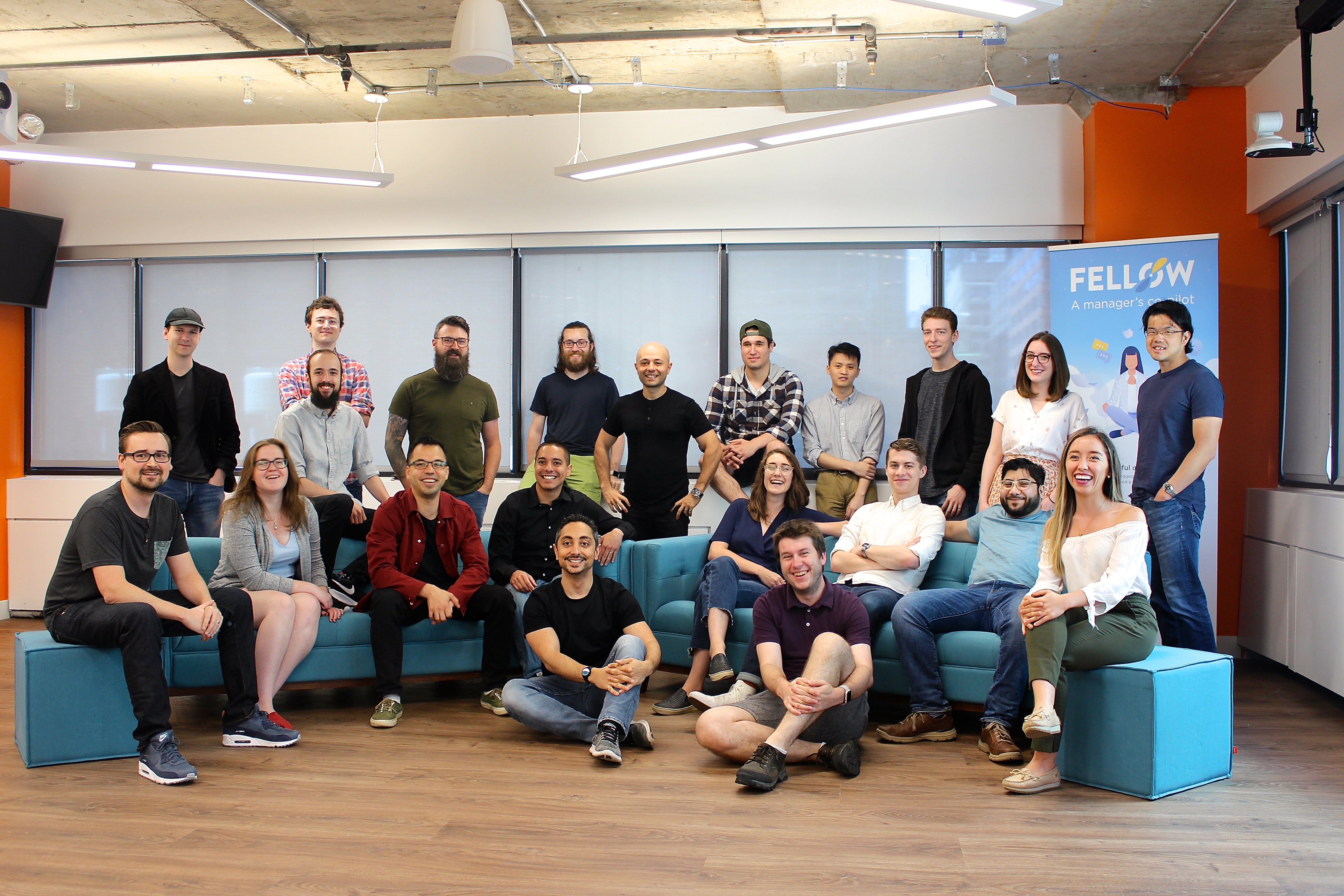
Mirzaee and his team then wondered why a tool like Salesforce or Marketo didn’t exist for management. “Why is it that when you get promoted to become a manager, there isn’t an equivalent tool to help you with that?” he said.
Concept in hand, Fellow set out to build its software, and what it came up with is a smartly designed, user-friendly platform that is accessible to anyone regardless of technical expertise or experience with management practice and training. I can attest to this first-hand, since I was a first-time manager using Fellow to lead a team during my time at Shopify – part of the beta testing process that helped develop the product into something that’s ready for broader release. I was not alone in my relative lack of management knowledge, Mirzaee said, and that’s part of why they saw a clear need for this product.
“The more we did research, the more we figured out that obviously, managers are really important,” he explained. “70% of customer engagements are due to managers, for instance. And when people leave companies, they tend to leave the manager, not the company. The more we dug into it the more it was clear that there truly was this management problem – management crisis almost, and that nobody really had built a great tool for managers and their teams like.”
Fellow’s tool is flexible enough to work with specific management methodologies like setting SMART goals or OKRs for team members, and managers can use pre-set templates or build their own for things like setting meeting talking points, or gathering feedback from the colleagues of their reports.
Right now, Fellow is live with a number of clients including Shoify, Vidyard, Tulip, North and more, and it’s adding new clients who sign up on a case-by-case basis, but increasing the pace at which it onboard new customers. Mirzaee explained that it hopes to open sign ups entirely later this year.
Powered by WPeMatico